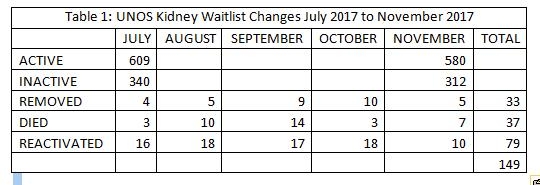Racing to Activation: Using LEAN Principles to Effectively Manage Your Waitlist with Predicted Improved Outcomes
MUSC, Charleston.
Meeting: 2018 American Transplant Congress
Abstract number: 582
Keywords: Kidney, Waiting lists
Session Information
Session Name: Concurrent Session: Quality Assurance Process Improvement
Session Type: Concurrent Session
Date: Tuesday, June 5, 2018
Session Time: 4:30pm-6:00pm
 Presentation Time: 5:18pm-5:30pm
Presentation Time: 5:18pm-5:30pm
Location: Room 2AB
Introduction: In July 2017, our waitlist was approximately 950 pts, 36% which were inactive. One coordinator & one program assistant managed the kidney waitlist. Review of the waitlist demonstrated that our strategies were ineffective based on the high % of pts inactive for extended periods of time (>1 yr). In anticipation of the need for a robust waitlist policy we leveraged our in house donor call group to facilitate evaluation of our active waitlist & our waitlist coordinator focused solely on the inactive list. Diversifying efforts was used to target pts that required on-site re-evaluation, additional testing or other multidisciplinary team resources. The aim of this study was to apply LEAN principles & aggressively manage the entire inactive waitlist over the course of 4 mos.
Methods: We employed the DMAIC Lean Six-Sigma process improvement strategy to our waitlist.
We defined our inactive waitlist starting as of May 24, 2017 and we designated this as our baseline cohort. Our measurement was evaluation of our waitlist and conversion to active, require re-evaluation or removal. The strategy to target individual pts was defined by our multidisciplinary team to identify pts at highest risk for mortality and those who would benefit most from activation based on age. Analysis of our interventions was evaluated weekly through team communication via email and collated monthly during our quality meetings. Improvement in the process was determined based on status on the inactive waitlist. Control included continual reprioritization of the inactive waitlist based on weekly data and overall assessment of the inactive list.
Results: All the inactive pts on the waitlist were reviewed during a 4 month period. Due to transplant volume equaling waitlist additions the distribution of the waitlist was not dramatically altered as shown in Table 1. However, the inactive list focus allowed the activation of pts <35 years of age and re-activation or delisting of those >65 yrs. Our total inactive waitlist was altered by 44% (149/340). 
Conclusion: We were able to improve accuracy of the waitlist without increasing FTE's predicting improved outcomes in graft survival and completed transplants.
CITATION INFORMATION: Curry L., Rao V., Cassidy D., Rohan V., Dubay D., Pilch N., Gray S. Racing to Activation: Using LEAN Principles to Effectively Manage Your Waitlist with Predicted Improved Outcomes Am J Transplant. 2017;17 (suppl 3).
To cite this abstract in AMA style:
Curry L, Rao V, Cassidy D, Rohan V, Dubay D, Pilch N, Gray S. Racing to Activation: Using LEAN Principles to Effectively Manage Your Waitlist with Predicted Improved Outcomes [abstract]. https://atcmeetingabstracts.com/abstract/racing-to-activation-using-lean-principles-to-effectively-manage-your-waitlist-with-predicted-improved-outcomes/. Accessed December 15, 2025.« Back to 2018 American Transplant Congress
